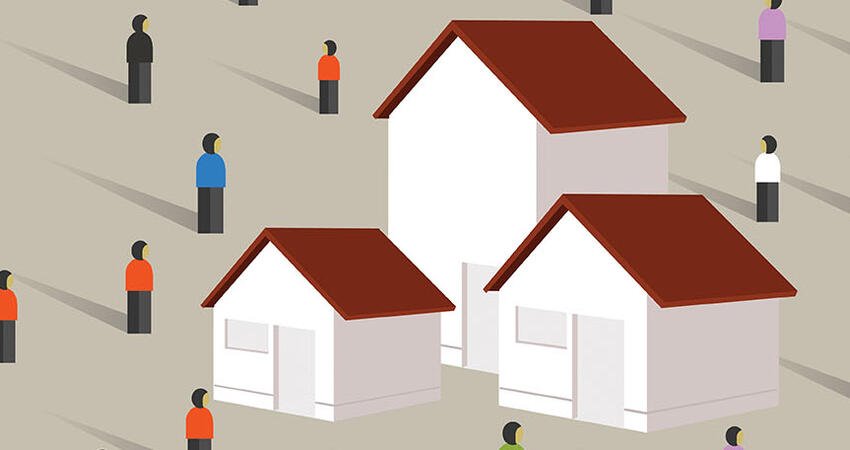
Secure and Healthy Housing Situations: Can the Proposed Budget Deliver?
by Maya Brennan and Veronica Gaitán
“A secure, healthy housing situation is a foundation on which families can establish economic security, improve their quality of life, and form strong communities.” – An American Budget, Fiscal Year 2019
That line in the administration’s budget proposal for fiscal year 2019 stands on a solid and growing base of evidence. Despite acknowledging this, the document does not describe a budget that expands access to secure, healthy housing. Instead, the budget describes a need for strategic funding during a period of fiscal constraint. Its initial sweeping cuts sum to an $8.8 billion reduction in funding for the US Department of Housing and Urban Development (HUD), an 18.3 percent cut compared with 2017 levels. Though an addendum brought the reduction down to $6.6 billion, major block grant programs and the public housing capital budget would receive no funding, the public housing operating budget would shrink, and several smaller programs would also face cuts.
The proposal asserts that the HUD budget “[reforms] programs to encourage the dignity of work and self-sufficiency” and “recognizes a greater role for state and local governments and the private sector to address community and economic development needs and affordable housing production.” What does evidence suggest about whether the budget proposal will help the nation achieve self-sufficiency goals? And how would the proposal affect states, localities, and the private sector?
The Budget and Self-Sufficiency
The budget proposal allots flat funding of $75 million for the Family Self-Sufficiency (FSS) program, which provides service coordinators to help participating HUD residents achieve upward mobility through five-year education and employment plans and an escrow savings account that automatically grows as their income (and therefore rent) increases. The budget line for the program is small because it leverages rental assistance as its primary resource and further draws on workforce development and asset-building partners. Reliable rental funding is an essential element of FSS, and that is subject to a deep budget cut.
The budget also allocates $10 million for the Jobs Plus program, down from $15 million in 2017. Jobs Plus provides employment services and income disregards within public housing to support employment for residents. The initial results were promising, so its continuation rests on a base of evidence. But cuts to public housing—the backbone of Jobs Plus—will make it harder for the program to work.
Reforms that would add a work requirement as a method of boosting self-sufficiency lack a strong evidence base. Nine housing authorities have adopted such requirements, and their flexibility or firmness in enforcement is not known. A rigorous evaluation of work requirements in Charlotte found that employment increased in some developments, but was unaffected for residents already enrolled in FSS. Rather than institute work requirements, perhaps increasing access to service coordinators would be as effective—or more.
The Budget, States, Localities, and the Private Sector
State and local governments play a substantial role in domestic policy. They allocate funds, establish regulations, deliver services, and otherwise apply a state or local sensibility to issues that require knowledge of specific assets, needs, and priorities. Federal funds, such as block grants, are a substantial part of their revenue. More than 22 percent of state and local general revenue comes from federal sources, according to the Tax Policy Center’s State and Local Finance Data Query System. Their budgets often get pinched when residents are in crisis—taking in less income and property tax revenue and spending more on health care and other service needs.
Homelessness provides a prime example of a housing crisis that ripples over to state and local budgets. According to HUD’s Annual Homeless Assessment Report to Congress, homelessness increased in 2017 for the first time in seven years. The budget request for $2.4 billion for the Homeless Assistance Grants program and $255 million for Emergency Solutions Grants would continue providing essential assistance to communities for their efforts in preventing and ending homelessness. Considering the cuts made to other housing programs, steady funding for these homeless reduction programs could seem like good news. But reductions in rental assistance will force homeless programs to work harder to re-house people who have nowhere to go and will leave more families scrambling to stay housed (currently only one in five households who are eligible for rent assistance receive it). The state and local role is to prepare for more homelessness or raise revenue to cover the gap.
The administration’s budget also eliminates programs that distribute flexible funds to states and localities, such as the Community Development Block Grant, and reduces federal funding for housing vouchers, public housing programs, and other programs with proven fiscal and nonfiscal benefits. Further, it increases the rent that non-elderly, non-disabled families receiving subsidies pay, from 30 percent to 35 percent and removes previously allowable deductions. The addendum to the budget proposal would prevent rent increases for elderly and disabled households.
On the private-sector side, $100 million in funding for the Rental Assistance Demonstration (RAD) program and the elimination of the Public Housing Capital Fund show that the administration sees private owners as the solution for assuring high-quality affordable developments for low-income renters. That is a lot of faith to put into a program that is still being evaluated. Some policy experts question the long-term affordability of RAD units—an element that is written into the program rules but has not yet been tested—and see a risk of “exposing housing developments to the unpredictability of the financial market.” Whether the long-term program capacity functions as intended or not, RAD’s ability to deliver on its immediate promise requires adequate rental funding at HUD—and often on the viability of the low-income housing tax credit (LIHTC), which was recently weakened by corporate tax cuts.
Private markets are experiencing an affordable rental housing shortage, so without federal assistance, only 21 adequate, affordable, and available rental units exist for every 100 extremely low–income renters. Meanwhile, more than half of LIHTC units have subsidies that will expire over the next decade.
Prior to the tax policy changes and the FY19 budget proposal, federal development incentives did not sufficiently entice the private market to deliver enough decent housing to meet the needs of extremely low-income households in any US county, and federal rental assistance resources did not fill the gap. Reduced resources suggest the gap will grow. States, localities, and the private sector can certainly do more to improve affordability, but there is no evidence to suggest they can fill the level of federal pull-back proposed in the budget. The likely result is less secure and less healthy housing.
The Verdict?
Housing is the first rung on the economic ladder to opportunity. Housing assistance gives low-income households the opportunity to improve quality of life and avoid severe rent burdens and substandard housing. Without reliable federal assistance, programs that support work, promote self-sufficiency, and attract non-federal resources and leadership face substantial challenges. Federal rental assistance is the foundation for self-sufficiency programs at HUD, the magnet that draws private sector investment, and the safety net that can catch people in crisis. The best available evidence shows federal funding shortfalls could have a detrimental effect not only on vulnerable households but on the ladder to self-sufficiency.


